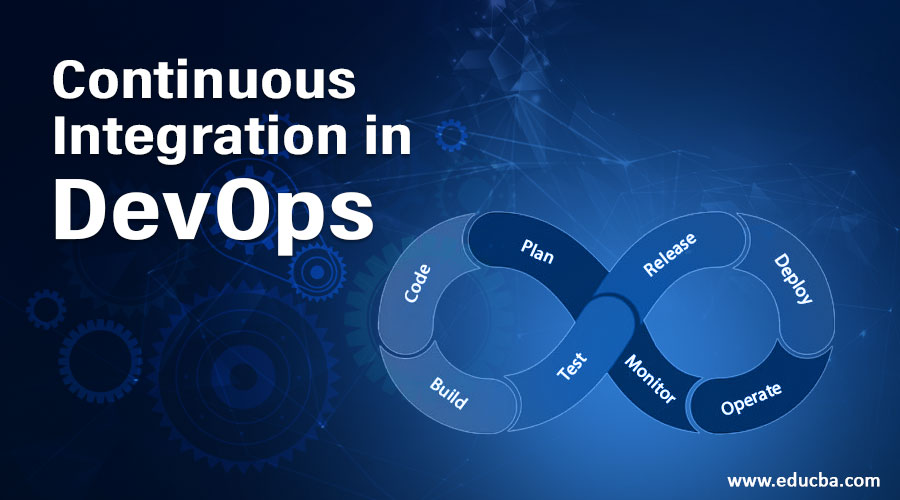Updated May 6, 2023
Introduction to Continuous Integration in DevOps
Continuous Integration in DevOps automates the build and deploy phase through specific tools and best practices. Continuous Integration (CI) applies to all software projects, such as developing websites, Mobile Applications, and Microservices based APIs. There are three major categories of tools associated with CI: versioning tools, build tools, and repositories for centralized artifacts. CI pipeline helps developers commit to the code easily and improves quality development. The Initial CI pipeline setup requires the significant expertise of DevOps; however, the process benefited the software development lifecycle after the design was implemented.
How is Continuous Integration Performed in DevOps?
- A developer develops or writes some code, often called patches representing a change to the project’s codebase [for example, a fix or bug].
- Merges the change to the centralized repository of that project like Git, SVN, and bitbucket vary with the project.
- If someone needs the codes in the centralized repository later or while composing the application, they can refer to the builds which can be deployed and manipulated or called at any time. These builds are often termed packages or artifacts.
Now comes into the picture another concern which can give the next thought to all scenarios, which are like branching strategies.
If thinking of the developer’s patch or any change, putting the entire change everywhere will be crucial. Therefore, continuous integration takes another stand as it provides a way to create a centralized repository with ease of branching and committing with time stamps. Gives Proper insight and information to developers and all the correlated teams and members.
If we leave the only question of branching and seek the other daily work performed manually, like writing code and merging, then sit by keeping our fingers crossed for what’s next, not an ideal way. Taking a perfect Continuous integration environment, every code change and patch should be committed and merged simultaneously with a test-driven environment incorporated within the CI environment to fulfill the automation.
Continuous Delivery and Continuous Deployment are part of Continuous Integration, which has helped to come automation so far by dividing and distributing all commits and patches into all new versions of different software.
Continuous Delivery means the simultaneous commits being made into the repository, and then it is the responsibility of the human to decide whether to take it further for deployment or not, which means human effort is being involved somehow, because of which companies don’t prefer and think twice before deployment.
On the other hand, many companies emphasize continuous deployment in the sense that they will directly put the commits and changes as a direct approach. But again, it involves many risks and can hamper or create bugs when a product goes into production. Thus, to mitigate the risk of bugs and make the Continuous Deployment process with Continuous Delivery and Continuous Integration more enhanced and powerful, one must introduce some new methods.
To fully adopt Continuous Integration, there are specific requirements that need to be fulfilled:
- Versioning Tool
- Build a tool
- Centralized artifact or repository
1. Versioning Tool
Continuous integration mainly depends on the versioning Tool. It is the very first requirement to make continuous integration possible. Few Versioning tools like git, SVN, bitbucket, etc. Again, it depends on the project requirement of which versioning Tool will be considered.
2. Build Tool
The second requirement is the build tool; the main motto of considering a build tool is to handle the application’s source code fetched from the version control tool to produce an output from the desired software in an automated way.
Steps to automate the build tool depends upon the chosen stack for technology. Suppose for Java; it must be that stack to initiate the automation.
- Configure the Tool and generate files with the .java extension.
- Compile the source code with .java extension to bytecode with .class extension.
- Compile the written test code to bytecode.
- Execution of all test cases.
- Packaging of the generated jars, whether maven or ant build, depends on the build tool.
- If needed, one can also tag builds and their releases to make them identifiable.
3. Centralized Artifact or Repository
Lastly, a place to keep all your hard work safely in a Version control system, artifacts that start to flow from VCS to build must also be stored. To get insight or added value in any software, one needs such artifacts. It acts as a repository manager to manage all the features of caching the data to use restrictions.
Advantages of using Continuous Integration in DevOps
The traditional method of code commits and merging with branches after every feature development becomes very tedious and increases the complexity of integration. But then merging again and again with the old feature and then releasing a branch in production can lead to the risk creation of bugs. Therefore, if continuous commits with continuous delivery and deployment are made, incorporating full-fledged DevOps can help enhance continuous integration.
The major advantage of this is it not only saves a developer’s time and lets them write quality code and focus on other tasks that can be a part of the task, which is essential and pivotal to understand. Thus, increasing the reliability of the product quality and reducing the bug and defect level while passing through live production. Without a second thought, teams can add new features and release code by writing a simple bash script.
Conclusion
It is difficult to adopt the CI method because it requires significant changes to the traditional or manual way of coding and development, in order to adopt the automated way of product release. To successfully adopt the method flow, the team should be in unison and agree to accept the new set of instructions or norms.
Recommended Articles
We hope that this EDUCBA information on “Continuous Integration in DevOps” was beneficial to you. You can view EDUCBA’s recommended articles for more information.



